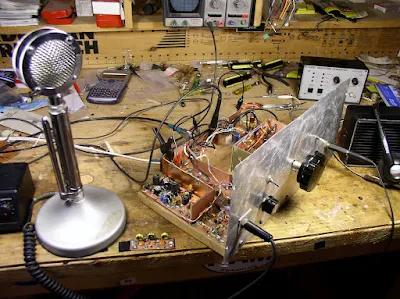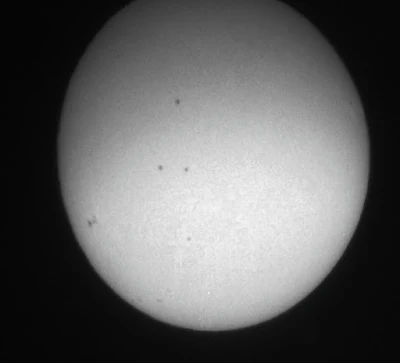When I look in the mirror and I see a haunted, obsessed look in my eyes. My wife senses that there is something wrong in the ham shack. She is right. I have an amplifier that wants to be an oscillator. Help me exorcise these gremlins! Guys, this problem is holding up the production of the next SolderSmoke podcast.
My JBOT amp works fine into a dummy load, but when I connect it to an antenna, it gets unstable. Here are some more details of the symptoms:
I am running the JBOT with a 5 element (two toroids, 3 caps) low pass filter (designed by Doug DeMaw and approved by Steve Smith).
With the antenna connected, all is well UNTIL I raise the power out (by varying the input) beyond about 1 watt. Below one watt, the amp is working fine, and it stable. As soon as I hit the 1 watt point, the amplifier seems to break into oscillation. This does not happen into the dummy load.
The antenna is a simple dipole fed by coax. It shows a low SWR. Even when I put an antenna tuner between the amp and the antenna and bring the SWR down to negligible levels, the instability problem persists.
With the amp disconnected from all other circuitry other than the antenna and the power supply, if I just touch the input capacitor, it breaks into oscillation. This does not happen when the amp is working into the dummy load.
I've bolstered the power supply filtering and decoupling. No luck. I tried some de-Qing of the transformers. No luck.
Any suggestions?
Our book: "SolderSmoke -- Global Adventures in Wireless Electronics"http://soldersmoke.com/book.htmOur coffee mugs, T-Shirts, bumper stickers: http://www.cafepress.com/SolderSmokeOur Book Store: http://astore.amazon.com/contracross-20
Serving the worldwide community of radio-electronic homebrewers. Providing blog support to the SolderSmoke podcast: http://soldersmoke.com
Podcasting since 2005! Listen to our latest pocast here:
Podcasting since 2005! Listen to Latest SolderSmoke
Thursday, November 17, 2011
Sunday, November 13, 2011
Backyard Solar Astronomy
 Over the weekend I took a break from JBOT amplifiers and did something I've been meaning to do for a long time: solar astronomy. I pulled out my old 4.5 inch Tasco reflector telescope and aimed it at old sol. I know, I know, this can be dangerous, but we were careful -- note that Billy is standing on the other side of the business end of the telescope. In his hands is the paper onto which we projected the solar image. I'd always wondered how I would get the sun into the telescope's field of view without risking my eyesight by using the finder scope. This turned out to be no trouble at all: I just looked at the shadow cast by the tube of the telescope and --using the shadow as my guide -- moved the tube until it was lined up with the sun. We snapped a picture of our results. I think our crude effort compared very favorably with the picture from NASA's Solar Dynamics Observatory. You can see the same sunspots in each image (ours is reversed because we were using a reflector). These images are from 12 November 2011.
Over the weekend I took a break from JBOT amplifiers and did something I've been meaning to do for a long time: solar astronomy. I pulled out my old 4.5 inch Tasco reflector telescope and aimed it at old sol. I know, I know, this can be dangerous, but we were careful -- note that Billy is standing on the other side of the business end of the telescope. In his hands is the paper onto which we projected the solar image. I'd always wondered how I would get the sun into the telescope's field of view without risking my eyesight by using the finder scope. This turned out to be no trouble at all: I just looked at the shadow cast by the tube of the telescope and --using the shadow as my guide -- moved the tube until it was lined up with the sun. We snapped a picture of our results. I think our crude effort compared very favorably with the picture from NASA's Solar Dynamics Observatory. You can see the same sunspots in each image (ours is reversed because we were using a reflector). These images are from 12 November 2011. Our book: "SolderSmoke -- Global Adventures in Wireless Electronics"http://soldersmoke.com/book.htmOur coffee mugs, T-Shirts, bumper stickers: http://www.cafepress.com/SolderSmokeOur Book Store: http://astore.amazon.com/contracross-20
"The Knack" on a Mysterious Island
 Paul, W2IOG, sent a nice e-mail about a very early use of the term "The Knack": 1874 by Jules Verne. (What word did he use in French?). I took a look at the Wikipedia page and discovered that there was indeed quite a bit of "The Knack" on Lincoln Island:
Paul, W2IOG, sent a nice e-mail about a very early use of the term "The Knack": 1874 by Jules Verne. (What word did he use in French?). I took a look at the Wikipedia page and discovered that there was indeed quite a bit of "The Knack" on Lincoln Island: "With the knowledge of the brilliant engineer Smith, the five are able to sustain themselves on the island, producing fire, pottery, bricks, nitroglycerin, iron, a simple electric telegraph, a home on a stony cliffside called "Granite House", and even a seaworthy ship. They also manage to figure out their geographical location."
Hello Bill,
I have been a listener to your Soldersmoke pod-casts for a couple of years now. I am also a regular reader of the blog as well as a long time victim of "The Knack". I was browsing an old book store the other day when I came across a beautifully illustrated copy of Jules Verne's book "The Mysterious Island" copyright 1920. I couldn't resist, and when I reached chapter nine of part one of the book I was really glad I had made the purchase. In the story, which takes place in 1853, castaways on an apparently uninhabited island are trying to make fire for the first time. After trying and failing to make sparks by striking stones together, two of the castaways try the following:
"Pencroft, although he had no confidence in the proceeding, then tried rubbing two pieces of dry wood together, as [primitive people] do. Certainly, the movements which he and Neb gave themselves, if they had been transformed into heat, according to the new theory, would have been enough to heat the boiler of a steamer! It came to nothing. The bits of wood became hot, to be sure, but much less so than the operators themselves.
After working an hour, Pencroft, who was in a complete state of perspiration, threw down the pieces of wood in disgust. 'I can never be made to believe that [primitive people] light their fires in this way, let them say what they will,' he exclaimed. 'I could sooner light my arms by rubbing them against each other!'
The sailor was wrong to despise the proceeding. [Primitive people] often kindle wood by means of rapid rubbing. But every sort of wood does not answer for the purpose, and besides, there is 'the knack,' following the usual expression, and it is probable that Pencroft had not 'the knack.' "
Congratulations on getting that 17 meter rig back on the air!
Paul W2IOG

Our book: "SolderSmoke -- Global Adventures in Wireless Electronics"http://soldersmoke.com/book.htmOur coffee mugs, T-Shirts, bumper stickers: http://www.cafepress.com/SolderSmokeOur Book Store: http://astore.amazon.com/contracross-20
Saturday, November 12, 2011
Sunspots! QRP DSB contacts on 17 meters

You can see here why I had so much fun in the summer of 2001 with my Azorean Homebrew QRP DSB rig. And why I am now re-CYCLING (get it?) and refurbishing the 17 meter gear that I built last cycle.
I've had the DSB rig on the air yesterday and have worked seven stations (2 watts peak DSB to a dipole).
Back to the Future! Someone on QRP-L said the SFI was recently at 180! Go Sol!
Our book: "SolderSmoke -- Global Adventures in Wireless Electronics"http://soldersmoke.com/book.htmOur coffee mugs, T-Shirts, bumper stickers: http://www.cafepress.com/SolderSmokeOur Book Store: http://astore.amazon.com/contracross-20
Thursday, November 10, 2011
JBOT Amplifier Installed in Azorean DSB Rig
 I've been remiss in posting to the blog, but I have a good excuse: I've been melting solder. I have working on the installation of my new Farhan-designed JBOT amplifier in my old Azorean DSB transceiver. I'm really enjoying this project, and I now see it as the first in a series. My shack has a number of creations that were built during the peak years of the last solar cycle, but have since fallen into disuse. Many of them were partially cannibalized -- usually it was the RF amplifier that was taken out. The JBOT was just what I needed. I plan to refurbish all of these rigs, adding a bit of India to each one of them. This is very much in keeping with our "International Brotherhood of Electronic Wizards" ethos.
I've been remiss in posting to the blog, but I have a good excuse: I've been melting solder. I have working on the installation of my new Farhan-designed JBOT amplifier in my old Azorean DSB transceiver. I'm really enjoying this project, and I now see it as the first in a series. My shack has a number of creations that were built during the peak years of the last solar cycle, but have since fallen into disuse. Many of them were partially cannibalized -- usually it was the RF amplifier that was taken out. The JBOT was just what I needed. I plan to refurbish all of these rigs, adding a bit of India to each one of them. This is very much in keeping with our "International Brotherhood of Electronic Wizards" ethos. The installation went fairly well, but with all of the ups and downs that accompany this kind of project. The amp worked fine on the bench, fed with a signal generator and into a dummy load. But of course, life got more complicated when I installed it in the rig. Yes, it took off on me. This was no fault of the amplifier -- I just needed to add some additional shielding. It is working fine now. See above. I moved it out of center stage and put it off in the corner to avoid feedback problems. More discussion of this in the next podcast (maybe this weekend).
Our book: "SolderSmoke -- Global Adventures in Wireless Electronics"http://soldersmoke.com/book.htmOur coffee mugs, T-Shirts, bumper stickers: http://www.cafepress.com/SolderSmokeOur Book Store: http://astore.amazon.com/contracross-20
Sunday, November 6, 2011
Tony Sale and the Re-Building of Colossus
 Steve "Snort Rosin" Smith sent us this, noting that "Tony Sale definitely had The Knack." As the Brits would say, "indeed."
Steve "Snort Rosin" Smith sent us this, noting that "Tony Sale definitely had The Knack." As the Brits would say, "indeed." http://mathdl.maa.org/mathDL/?pa=mathNews&sa=view&newsId=1195
Amazing info on Tony Sale's work here:
http://www.codesandciphers.org.uk/lorenz/index.htm
I got a kick out of this bit:
One reason for wanting to get Colossus working in 1996 was that for far too long the Americans have got away with the myth that the ENIAC was the first large-scale electronic digital calculator in the world. It was not, but they got away with it because Colossus was kept secret until the 1970s. As 1996 was the 50th anniversary o the switch-on of ENIAC I made sure that Colossus was rebuilt and working in Bletchley Park, just as it was in 1944.
There has been a stunned silence from across the water!
Our book: "SolderSmoke -- Global Adventures in Wireless Electronics"http://soldersmoke.com/book.htmOur coffee mugs, T-Shirts, bumper stickers: http://www.cafepress.com/SolderSmokeOur Book Store: http://astore.amazon.com/contracross-20
Saturday, November 5, 2011
21st Century Ham Radio -- EDN Article
A few listeners sent this in. Thanks! Note the mention of AA1TJ's CFL light bulb rig!
http://www.edn.com/article/519742-Ham_radio_in_the_21st_century.php
Our book: "SolderSmoke -- Global Adventures in Wireless Electronics"http://soldersmoke.com/book.htmOur coffee mugs, T-Shirts, bumper stickers: http://www.cafepress.com/SolderSmokeOur Book Store: http://astore.amazon.com/contracross-20
http://www.edn.com/article/519742-Ham_radio_in_the_21st_century.php
Our book: "SolderSmoke -- Global Adventures in Wireless Electronics"http://soldersmoke.com/book.htmOur coffee mugs, T-Shirts, bumper stickers: http://www.cafepress.com/SolderSmokeOur Book Store: http://astore.amazon.com/contracross-20
Subscribe to:
Comments (Atom)

